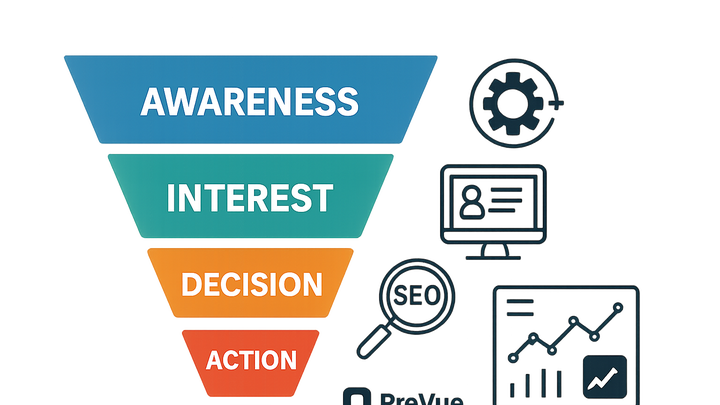Published on 2025-06-29T19:25:35Z
What is a Sales Funnel? Examples of Sales Funnels.
The sales funnel is a framework that illustrates the customer journey from initial awareness of a product or service to the final purchase decision.
It is typically divided into stages—Awareness, Interest, Decision, and Action—that help marketers and UX designers tailor their strategies to the user’s needs at each step.
Understanding the funnel enables teams to optimize website design, content, and calls-to-action for maximum conversion, making it essential for CRO, SEO, and overall user experience.
Tools like PreVue.me offer actionable critiques to identify drop-off points, improve accessibility, and enhance lead generation across the funnel.
By analyzing metrics at each stage, organizations can refine messaging, streamline navigation, and ultimately drive more qualified leads through to conversion.
The sales funnel also informs SEO tactics by aligning keyword strategies with user intent at different funnel levels, ensuring content reaches the right audience at the right time.
Sales funnel
A sales funnel maps the customer journey from awareness to purchase, guiding CRO, UX, and SEO strategies to boost conversions.
What is a Sales Funnel?
A concise overview of what a sales funnel is and the key stages that guide a visitor from awareness to conversion.
-
Definition
The sales funnel is a model that maps the stages a prospect goes through, from becoming aware of your brand to making a purchase. It helps teams identify objectives and optimize strategies at every step.
-
Key stages
The funnel typically comprises four stages:
- Awareness:
The stage where potential customers first discover your brand or product.
- Interest:
Prospects engage with your content, evaluating whether your solution fits their needs.
- Decision:
Leads compare options and weigh the benefits, pricing, and features.
- Action:
The prospect completes a desired goal, such as a purchase or form submission.
- Awareness:
Why a Sales Funnel Matters for CRO, UX, and SEO
Explores how the sales funnel framework drives targeted optimizations across conversion rate, user experience, and search visibility.
-
Conversion rate optimization (cro)
By analyzing funnel metrics like drop-off rates, CRO teams can A/B test and refine calls-to-action, forms, and page layouts to improve conversions.
-
User experience (ux)
Mapping user journeys within the funnel highlights friction points, helping UX designers streamline navigation, content hierarchy, and accessibility.
-
Search engine optimization (seo)
Aligning content with each funnel stage allows SEO specialists to target keywords based on user intent, improving organic traffic quality and relevance.
Leveraging PreVue.me for Funnel Critiques
Details how PreVue.me SaaS tool can be used to audit and optimize each stage of the sales funnel with actionable feedback.
-
Funnel analysis dashboard
Provides a holistic view of user drop-offs, engagement rates, and conversions across funnel stages.
-
Actionable recommendations
Offers prioritized suggestions for improving CTAs, page layout, and form fields based on CRO best practices.
-
Ux & accessibility feedback
Identifies usability issues, navigational barriers, and accessibility compliance gaps that hinder funnel progression.
-
Seo & lead generation insights
Analyzes keyword alignment, meta-data effectiveness, and content gaps to boost organic reach and attract qualified leads.
Examples of Sales Funnels
Real-world funnel structures implemented in different business models to illustrate best practices.
-
E-commerce funnel
A typical E-commerce funnel includes product discovery via organic search or ads, product page visits, cart additions, and purchase completion.
-
Saas subscription funnel
This funnel starts with free trial sign-ups, followed by onboarding emails, in-app feature engagement, and subscription conversion.
-
B2b lead generation funnel
Begins with gated content downloads, nurture email campaigns, demo requests, and closes with a sales consultation.
Best Practices and Common Pitfalls
Summarizes key recommendations and mistakes to avoid when designing and optimizing sales funnels.
-
Best practices
Ensure a seamless progression through the funnel with clarity, consistency, and targeted messaging.
- Clear ctas:
Use concise, action-oriented CTAs that align with the user’s stage in the funnel.
- Segmented content:
Tailor content and offers to different audience segments and intent levels.
- Ongoing testing:
Continuously A/B test and refine elements to adapt to user behavior and preferences.
- Clear ctas:
-
Common pitfalls
Watch out for these frequent mistakes that can derail conversion efforts.
- Ignoring analytics:
Failing to track and analyze funnel metrics prevents data-driven improvements.
- Overloading forms:
Asking for too much information upfront can increase abandonment rates.
- Generic messaging:
Using one-size-fits-all copy can fail to address specific user needs and motivations.
- Ignoring analytics:
